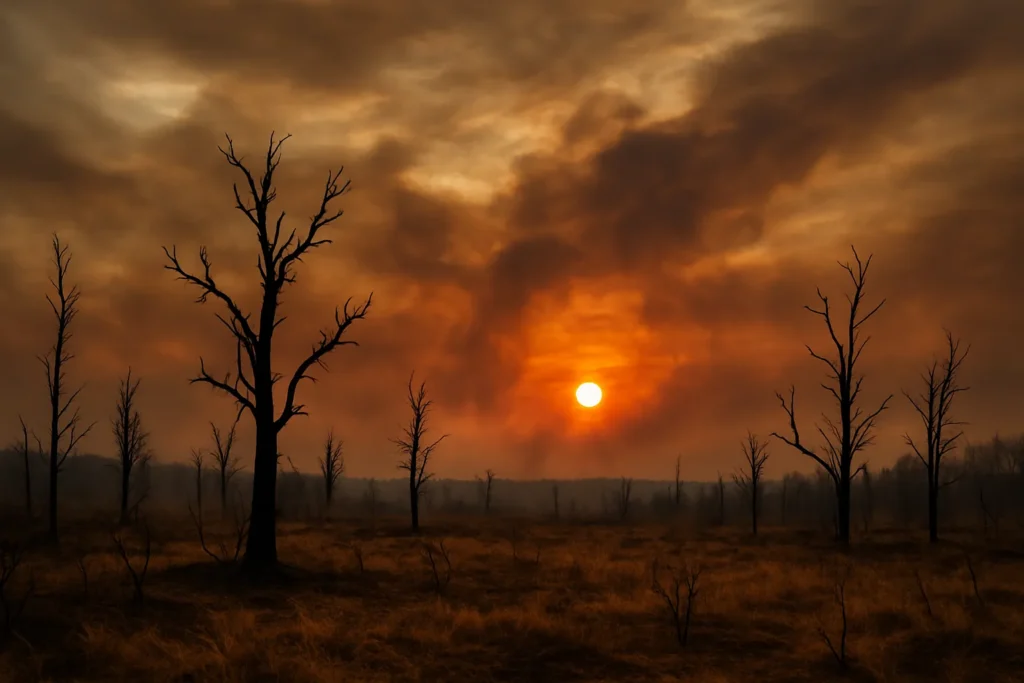North America Choked by Widespread Wildfire Smoke
Wake up, look out your window, and catch the eerie, jaundiced glow streaking across city skylines—from Salem, Oregon to the heart of Manhattan. That haze? It’s not some far-off abstraction. It’s the immediate, visible consequence of unprecedented wildfires now ravaging large swaths of North America.
Satellite imagery doesn’t lie. In recent weeks, vast plumes of smoke have originated from Canada’s Northwest Territories, Saskatchewan, and Manitoba, blanketing the continent from Alaska down into the Great Lakes and all the way to the Atlantic. According to the National Interagency Fire Center, this summer is on pace to rival 2023’s record for days spent under air quality alerts—a reality confronting millions with red, irritated eyes and throats scratched raw.
Consider the Monroe Canyon blaze in Utah or the Dragon Bravo fire tearing through northern Arizona. Both are producing thick, hazardous smoke, drifting for hundreds of miles. Meanwhile, the Gifford Fire in southern California isn’t content to be a local crisis—its billowing plume now ripples over the Channel Islands and dissipates deep into the Pacific Ocean. Up north, the Bear Gulch fire at Washington State’s Olympic Peninsula pipes persistent light smoke eastward, dusting the Puget Sound and Cascade foothills. Vancouver Island sent dense smoke plumes northwest, carrying the ecological consequences well outside its boundaries.
Who feels the brunt of these choking conditions? Indigenous communities, agriculture workers, the elderly—groups all too often left behind by reactive, shortsighted policymaking. Emergency departments across the U.S. and Canada are seeing respiratory complaints climb, especially among children and seniors (as highlighted by the American Lung Association in June 2024). This isn’t a distant threat. It’s our present, our air, our lungs—being robbed of clarity and safety.
Climate Policy Paralysis: Conservative Neglect, Public Health at Risk
Why do our skies look like a perpetual sunset, and who’s really to blame? There’s no longer any serious scientific debate that rising global temperatures are fueling longer, more intense wildfire seasons. Yet, conservative policymakers remain stubbornly married to fossil fuel interests, refusing even modest investments in green infrastructure. Deferring action on climate only makes these disasters more frequent and more extreme.
Harvard climate scientist Dr. Michael Syme, in a May 2024 panel, emphasized: “Every year of delay compounds the ferocity of wildfires. Policy matters, and the cost of inaction is paid in lives and livelihoods.” Yet, major conservative players across Congress continue to challenge EPA regulations and block funding for wildfire mitigation research. Look to Oregon’s Marion County, where county commissioners have dragged their heels on updating forest management approaches and climate adaptation strategies, in part due to ideological opposition directed at environmental regulations.
What does this mean for communities on the ground? Potential class closures due to unsafe air, canceled public events, agricultural work stoppages—and untold millions in economic losses. On days when the Air Quality Index soars, families are warned to stay indoors, children are kept from playgrounds, and workers in fields and warehouses are left with few choices but to risk their health or risk their paychecks.
“Every summer, the smoke comes. We hand out masks to our farm crews as if wildfire season is just a given now. It wasn’t always like this,” said Maria Torres, a Salem-area farm manager. “Yet our leaders keep pretending it’s some fluke of nature, not the new normal.”
The repeated refrain—‘personal responsibility’ or free-market solutions—rings hollow against the backdrop of moms stretching sheets under doors and seniors stockpiling inhalers. Stripped bare, this conservative approach leaves working families and vulnerable seniors bearing the real costs, while special interests dictate policy from afar.
The Path Forward: Demanding Accountability and Urgent Reform
An honest reckoning with our wildfire crises demands more than thoughts and prayers or overhyped rhetoric about “forest mismanagement.” It requires robust, science-centered public policy, aggressive emission cuts, and transparent disaster planning. Experts from the Union of Concerned Scientists argue that communities must be equipped with both adaptation resources and rigorous investment in sustainable energy to slow this lethal spiral.
Consider how Australia and parts of Southern Europe have responded in the wake of devastating wildfires: whole-of-government emergency drills, rural fire service funding, and modernization of aerial firefighting fleets. The U.S. and Canada need similarly ambitious, federally coordinated responses—ones that challenge industry inertia and prioritize community health.
Beyond that, real leadership means fighting for environmental justice by channeling resources into frontline communities. That includes Indigenous nations—often stewards of vast swathes of forest—who possess centuries-old knowledge about landscape management. Ignoring their voices, as has so often happened under conservative leadership, is not only shortsighted but unjust.
This summer’s suffocating haze is no one-off. The cascade of red-flag warnings and desperate air filter drives are signposts for a nation at the crossroads. Will we demand the policies our climate scientists and public health officials are shouting for? Or will we let the heat, smoke, and political finger-pointing smother what’s left of our collective breath?
As author and climate advocate Mary Heglar writes, “Climate action is a matter of love and necessity, not just data.” That love must drive a new urgency—a willingness to prioritize the air our grandchildren will breathe, and the forests they’ll inherit. Change won’t come unless we push for it, together, here and now.

